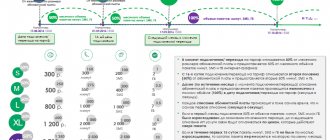General provisions
The word “orbit” translated from Latin means “road”, “track”.
This term was used by the great German scientist Johannes Kepler at the beginning of the 17th century. named the trajectory of movement of celestial bodies in outer space. They discovered and formulated the basic laws of their movement. After the launch of the world's first Soviet Earth satellite, Sputnik 1, in October 1957, concepts such as “artificial celestial body” or “artificial Earth satellite” became a reality. Their movement obeys the same empirical laws of Kepler. Kepler's first law states that the trajectory of the planets is an ellipse, with the Sun at one of its foci. A special case of planetary motion is motion in a circular orbit (in this case, the eccentricity of the ellipse, i.e., the ratio of the distance between the foci to the major axis, will be equal to zero or differ little from zero). In accordance with Kepler's first law, one of the foci of the ellipse along which an artificial celestial body moves in the Earth's gravitational field must be in the center of the Earth. It follows that an artificial satellite of the Earth cannot move along its parallel, with the exception of the equatorial plane. The second focus will be located at the same distance from the apogee of the satellite’s orbit as the center of the Earth is from its perigee (Fig. 1).
Rice. 1. Geometric illustration of Kepler’s first law, where: a is the semimajor axis of the ellipse; b – semiminor axis of the ellipse; O (center of the Earth) and O` – focuses; c – distance between foci
According to Kepler's second law, the radius vector of the planet describes equal areas in equal periods of time (Fig. 2). From Kepler's second law it follows that the planet moves unevenly around the Sun, having a higher linear speed near perigee than near apogee.
Rice. 2. Geometric illustration of Kepler’s second law, where: O is the center of the Earth; Rc – radius vector of the satellite
The third law states: the squares of the time of revolution of the planet around the Sun are proportional to the cube of the semi-major axis of the ellipse a (see Fig. 1):
where: Tc – period of revolution of the planet in orbit; a is the magnitude of the semi-major axis of the ellipse;
k – constant.
That is, the lower the orbital altitude, the shorter the orbital period.
In general, any satellite orbit is described by a number of parameters, the main ones being:
- geometric shape of the orbit;
- the altitude of the satellite's orbit, defined as the shortest distance to the earth's surface in kilometers;
- orbital inclination is the angle between the equatorial plane and the orbital plane.
According to their geometric shape, orbits are divided into circular and elliptical and differ in inclination to the equatorial plane. When they coincide with the plane of the equator, they are called equatorial. Orbits perpendicular to the equatorial plane are called polar. Based on the orbital height above the earth's surface (H), they are conventionally divided into low (H ≤ 2000 km), medium (H = 2000...20000 km) and high (H ≥ 20000 km). A special place among the various orbits is occupied by highly elliptical orbits with a large ratio between the apogee and perigee heights.
The point of intersection with the Earth's surface of the radius vector connecting the satellite with the center of the Earth is called the sub-satellite point. At this point, the observer sees the satellite at the zenith. When deviating from the sub-satellite point, the distance from the observer to the satellite increases, and the deviation from the zenith can be described by two angular quantities: azimuth and elevation [1].
The idea of using artificial devices
The very concept of geostationary orbit was initiated by the Russian inventor K. E. Tsiolkovsky. In his works, he proposed populating space with the help of orbital stations. Foreign scientists also described the work of cosmic fields, for example, G. Oberth. The man who developed the concept of using orbit for communication is Arthur C. Clarke. In 1945, he published an article in Wireless World magazine, where he described the advantages of the geostationary field. For his active work in this field, in honor of the scientist, the orbit received its second name - the “Clark Belt”. Many theorists have thought about the problem of implementing high-quality communication. Thus, Herman Potochnik in 1928 expressed the idea of how geostationary satellites could be used.
Geostationary orbit
A circular orbit with an altitude of 35,880 km, lying in the equatorial plane of the Earth, is called a geostationary orbit (GSO). A satellite, when moving along this orbit in the eastern direction, makes a revolution around the Earth in one sidereal day (23 hours 56 minutes 4 seconds) and, therefore, will constantly be above a certain point on the Earth's equator (subsatellite point). This is the uniqueness of the geostationary orbit.
The visibility zone from a geostationary satellite is quite large and occupies about one third of the earth's surface (Fig. 3). However, the polar zones remain out of sight. The visibility of a satellite from Earth is determined not only by latitude, but also by longitude.
Rice. 3. Geostationary satellite visibility area
Artificial Earth satellites that are in geostationary orbit twice a year during periods of time close to the autumn and spring equinoxes fall into the Earth's shadow. The time of each shading does not exceed 1 hour 10 minutes.
Satellite communications using spacecraft (SC) in geostationary orbit is a fairly universal means of transmission and allows the implementation of a wide range of services in the field of long-distance and international telephone and fax communications, data transmission, distribution of sound and television broadcasting programs, transmission of newspaper strips, direct audio and television broadcasting, access to the Internet, providing access to multimedia services. Satellite geostationary systems are also used to organize VSAT networks of various configurations, to reserve terrestrial communication channels, collect monitoring information, etc.
The international legal status of the geostationary orbit proclaims and secures the section of near-Earth space that makes up the geostationary orbit as the “property of all mankind” and is intended to ensure its effective and safe use, as well as access to it by all states on a fair and rational basis. A significant contribution to solving the problems of developing an effective international legal status for GSO is made by the United Nations (UN), its bodies (UN Conference on the Exploration and Peaceful Uses of Outer Space, the UN Committee on Outer Space and its Scientific, Technical and Legal Subcommittees) and specialized establishment of the International Telecommunication Union (ITU). Detailed technical rules and procedures for the use of the radio frequency spectrum and geostationary orbit are contained in the ITU Radio Regulations [2, 3].
Currently, more than 500 objects of artificial origin (satellites, rocket stages, individual fragments) have been recorded on the GEO. Of these, about half are operational communications and broadcasting satellites, owned by both international organizations and individual states or private companies.
The first Soviet geostationary satellite “Raduga” (“Statsionar-1”) put into operation in the interests of the Ministry of Defense of the Russian Federation was launched to a sub-satellite point 85o. in December 1975 using the Proton-K launch vehicle.
The Russian constellation of civil communications satellites currently consists of 15 operating spacecraft owned by the Federal State Unitary Enterprise "Space Communications" and OJSC "Gazprom - Space Systems".
Kepler's laws are valid when planets or satellites move in a gravitational field in which there are no disturbing factors. The orbits of artificial Earth satellites, due to the smallness of their masses, can change under the influence of external disturbing forces. The deviation of the movement of geostationary satellites of the Earth from a given orbit is caused by the non-sphericity of the Earth, the attraction of the Moon and the Sun, the pressure of the solar wind, etc. As a result of this, the geostationary satellite gradually shifts along the orbit towards four points of a stable state (75.3° East, 104.8°W, 166.3°E and 14.7°W), and the inclination of its orbit towards the equator is increasing at a rate of 0.85° per year.
In accordance with current requirements, satellites during long-term operation (up to 15-16 years) must be kept in geostationary orbit with an accuracy of ±0.1º. This implies the need for periodic correction of the position of satellites in orbit. Correction is carried out in the north-south direction to maintain a given inclination and in the east-west direction to keep the satellite in its assigned position within the geostationary belt.
To maintain the given position of the satellite in geostationary orbit, special correction engines are installed on the spacecraft platform, as well as a supply of fuel for them (“working fluid”). The mass of the working fluid can be hundreds of kilograms. The fuel supply in many cases determines the active life of the spacecraft. Correction engines can be chemical, electric rocket or plasma. The engines are turned on periodically once every few days. These same engines can be used to move the satellite, if necessary, to another point on the geostationary orbit.
On geostationary satellites, a reserve of fuel is provided for transferring a spacecraft that has exhausted its life or is subject to replacement to a disposal orbit. The burial orbit is 200−300 km above the geostationary orbit.
The disadvantages of communication systems using geostationary satellites include:
- long signal propagation time along the Earth-satellite-Earth line - 0.24 s;
- impossibility of communication with the Arctic regions of the Earth;
- increased energy requirements for “Earth–satellite” and “satellite–Earth” communication lines due to the large length of the route;
- limited potential in terms of the number of satellites placed in orbit.
Hidden threat
Several information industry giants have expressed their desire to "be in space." Facebook has so far gone the traditional route and is deploying a network in Africa based on geostationary Ka-band capacity. Google is gushing with plans that combine satellites, unmanned vehicles, and balloons. At the company’s initiative, interesting experiments are certainly being carried out (with the same solar-powered drones), but no one is talking about commercial implementation or at least a prototype of a business model for use. And even Apple in April hired satellite communications specialists (one of them, by the way, is a former Google employee) and began preliminary negotiations with Boeing regarding the use of the low-orbit system being designed by the company, operating in the V-band (40-75 GHz).
Low-flyers will play a significant role in the coming IoT boom. Experts predict there will be about 100 billion devices in this area by 2025, and satellite operators (both new and existing) do not intend to miss out on this market. Here the main focus is on micro- and even nanosatellites. A typical project (of those that have gone a little further from the concept stage) is the Australian startup Fleet, which plans to launch 100 nanosatellites for IoT in 2021. This company recently received $3.7 million in funding.
Elon Musk has advanced much further than his predecessors and contemporaries. Last year, it attracted $2.5 billion in investment from SoftBank, which covered more than half the amount required to deploy the system. Already at the beginning of this year, with the participation of the same bank, OneWeb tried to merge with Intelsat. The synergy of two such different, but perfectly complementary technologies could result in a simply killer conglomerate, which would be extremely difficult to compete with. But Intelsat shareholders did not like the terms of the merger, and it did not take place. At the same time, both operators are confident in the positive effect of the possible merger.
Low orbits
Due to the congestion of the geostationary orbit in the last two decades, much attention has been paid to multi-satellite communication systems with spacecraft located in low orbits. The space segment in this case is built from a collection of satellites forming an orbital constellation. Satellites can be in circular or elliptical orbits, evenly spaced above the Earth's surface so that geographic points of interest on Earth have radio visibility to at least one spacecraft. For such satellite systems with circular orbits, the orbital altitude is usually selected between 600 and 1500 km. This is due to the fact that at lower altitudes the effect of the atmosphere is felt, which leads to inhibition of the satellite’s movement and a gradual decrease in the altitude of its orbit.
At altitudes above 1500 km there is the Earth's inner radiation belt (Van Allen belt), which is divided into inner and outer zones (Fig. 4). In these zones, the Earth's magnetic field retains charged particles (protons, electrons, α-particles) with high kinetic energy from tens of keV to hundreds of MeV. In the inner zone, at an altitude of approximately 3000 km, there is a maximum flux density of high-energy protons (20...800 MeV).
Rice. 4. Location of the Earth's radiation belts
The gap between the inner and outer zones ranges from 5,000 to 15,000 km. The presence of equipment, especially semiconductor equipment, in the Van Allen radiation belts leads to the appearance of defects in the crystals and, ultimately, to failures in the operation of the equipment. Therefore, when choosing an altitude for low-orbit satellites, altitudes for long-term presence of satellites in the Earth’s radiation belts should be excluded.
The advantage of low-orbit systems is the ability to use compact and relatively cheap user terminals due to the shorter distance between the satellite repeater and earth stations compared to geostationary satellite systems, as well as the creation of a global system and communication with subscribers located anywhere on the earth's surface. In addition, launching artificial satellites requires relatively small launch vehicles; the choice of launch site for the launch vehicle is less critical.
Low-orbit systems with delayed signal transmission (telegraph, e-mail) have been used for many years, mainly for special purposes. Such systems are unsuitable for telephone communications and real-time data transmission. The visibility zone of a low-flying satellite in the form of a spot continuously moves along the earth's surface and is available to the subscriber, depending on the size of this spot, for 10-15 minutes. To ensure continuity of communication, a continuous change of visibility zones from successive satellites and a corresponding switching of the communication line between two subscribers are required. Therefore, there must be quite a lot of satellites. In low orbits, their number should usually be 48 or more [4].
For the operation of satellites located at any point on the Earth, it is necessary to use inclined rather than equatorial orbits. The best option for global service is polar orbits (inclination angle 90°). The use of multiple polar orbital planes carries the risk of satellite collisions. Therefore, circumpolar orbits with an inclination of 80...86o are more often used. The choice of inclination angle is also determined by the geographical location of the launch vehicle launch complex, with the help of which the spacecraft is launched. Any launch of a launch vehicle is associated with the fall of spent stages to Earth. The permissible area for the fall of these stages is strictly specified for any cosmodrome, which determines the possible angles of inclination. The active lifespan of low-orbit satellites is usually shorter than that of geostationary or medium-altitude satellites, due to the fact that these satellites spend much longer time in the Earth's shadow, and this leads to difficulties in providing power on board (a large number of battery charging and discharging cycles). The shading time is approximately half the orbital time. When the spacecraft is illuminated and shaded, the spacecraft elements are heated and cooled, respectively, to temperatures of +100 and −150 °C. To reduce energy consumption, it is possible to switch to reduced power consumption by the payload when the satellite passes areas of the Earth's surface with zero or little traffic.
In Russia, in March 2015, the deployment of the global low-orbit satellite communication system “Gonets” was completed, consisting of 12 satellites and designed to organize the transmission of information using the “e-mail” principle. The orbital constellation consists of four planes with three spacecraft in each plane. The circular orbit has an altitude of 1500 km and an inclination of 82.5°.
Currently, two low-orbit telephone communication systems are deployed in the world - Iridium and Globalstar [5]. Both systems have their segments in the Russian Federation.
The Iridium orbital constellation consists of 66 satellites orbiting the Earth in 11 orbits at an altitude of approximately 780 km. It is the only civilian satellite telephone system that covers 100% of the Earth's surface, including the polar regions. A distinctive feature of the system is the presence of intersatellite communication.
The space segment of the Globalstar system, which provides telephone communications, consists of 48 satellites at an altitude of 1414 km with an inclination of 52°. There are 6 satellites on each of the eight orbital planes. Due to the low inclination angle, the service area of the system is within the range of 0−75° N. and Yu. w. There are three stations in Russia that interface the Globalstar system with the country's public network.
Basics of Satellite Communications – Satellites
Satellites are relay stations in space for voice, video and data transmission. They are ideal for meeting the global communications requirements of military, government and commercial organizations. Because they provide cost-effective, scalable and highly reliable transmission services over wide geographical areas.
Transmission via satellite communications systems can bypass existing terrestrial cellular tower infrastructure, which is often limited and unreliable in many parts of the world.
Highly elliptical orbits
At one time, the use of a highly elliptical orbit in satellite communication systems with Molniya satellites acquired great practical importance, especially in our country. This orbit (also called "Molniya") is characterized by a large ratio of apogee altitude (40,250 km) to perigee altitude (500 km). When the apogee is in the Northern Hemisphere, a wide visibility zone of the territory of Russia, including the circumpolar regions, is created for at least 8 hours. The orbital period in such an orbit is 12 hours. With the help of three or four satellites in such highly elliptical orbits, it is possible to organize round-the-clock communications between almost any point on Russian territory. As a rule, a system constellation using the high-orbit Molniya orbit consists of four spacecraft, shifted in time by 6 hours. Each satellite passes the apogee point twice during the day: the first time over the eastern hemisphere (main orbit), the second time over the western hemisphere (conjugate orbit) [6].
The disadvantages of satellite communications in highly elliptical orbits include the need to build ground stations with tracking antennas. These systems are also affected by the Doppler effect, leading to a change in the frequency of received oscillations depending on the rate of change in the distance between the satellite and the ground station.
The launch of the first highly elliptical satellite "Molniya-1" in the Soviet Union was carried out on April 23, 1965 in order to provide long-distance telephone and television communications between Moscow and the Far East.
A number of projects are considering a highly elliptical orbit such as Tundra, which is a highly elliptical orbit with a 24-hour orbital period. The eccentricity of such an orbit is significantly less than that of the Molniya type orbit, which brings it closer to circular (see table). In particular, such an orbit was chosen for the only civil system in the Western world using the highly elliptical Sirius orbit.
Table. Main characteristics of the Molniya and Tundra orbits
| Orbital elements | Orbit type | |
| Lightning | Tundra | |
| Period, s | 43 063 | 86 164 |
| Semimajor axis, km | 26 554 | 42 184 |
| Inclination,° | 63,4 | 63,4 |
| Perigee argument, ° | 270 | 270 |
| Perigee altitude, km | 1000 | 21 029 |
| Apogee height, km | 39 352 | 50 543 |
| Eccentricity | 0,722 | 0,35 |
| Duration of communication session over the serviced territory during the day, hours | 8 | 8 |
| Minimum number of satellites for 24/7 service | 3 | 3 |
| Crossing belts with increased radiation | 4 times a day | Do not intersect |
| Visibility of Russian territory from apogee (mid-session) | Full | Full |
| Visibility of Russian territory from apogee (beginning and ending of the session) | Incomplete | Full |
Due to the long stay of the spacecraft at the apogee, highly elliptical orbits of the Molniya and Tundra types are sometimes called quasi-geostationary. It is possible to construct similar orbital constellations with a significantly lower apogee value with an orbital period of 4, 6 or 8 hours, while, naturally, a larger number of spacecraft is required to ensure constant time coverage.
The different construction of elliptical orbital constellations makes it possible to solve the main issue of satellite communications - to significantly increase the capacity of “space” and provide equal conditions for access to satellite communications in the circumpolar regions of the Earth. Today, as theoretical studies and long-term practice of space communications show, the Molniya type orbit has the greatest number of positive qualities.
Currently in Russia there is a group of four Meridian spacecraft in operational orbits, which has a dual purpose (Fig. 5). Civil tasks include organizing satellite communications between ships and aircraft in the area of the Northern Sea Route with coastal stations and creating a communication network for the northern regions of Siberia and the Far East.
Rice. 5. Ground track of the Meridian spacecraft (https://ru.wikipedia.org)
Despite the fact that our country has priority in the practical use of a highly elliptical orbit, further continuation of work on the wider development of this type of orbit has slowed down. Provided by the Federal Space Program for 2006−2015. The deployment of a direct satellite radio broadcasting system using highly elliptical satellites of the Express-RV type has not been implemented. The next estimated launch date for highly elliptical satellites for purely civilian purposes is 2020−2021.
The project of the Russian satellite communication system "Polar Star" with spacecraft located in highly elliptical orbits, which is intended for mobile and fixed communication services of government and state bodies, the population and transport throughout Russia, including the northern and eastern regions, developed by OJSC Gazprom - Space systems” is also not making much progress. Most likely, this is due to the low economic efficiency of such systems.
Types of Satellite Communications
The commercial foundations of satellite communications fall into three main service categories:
Fixed satellite services (FSS): use ground-based equipment at designated locations to receive and transmit satellite signals. FSS satellites support most of our domestic and international services, from international Internet connections to private business networks.
Mobile satellite services (MSS): use a variety of man-portable receiving and transmitting devices to provide communications services to land mobile, maritime and aeronautical users.
Broadcast satellite services (BSS, FSS): offer high transmit power for reception using very little ground equipment. FSS is used for television and broadband applications such as DIRECTV.
Transfer orbits
When describing satellite launch processes, concepts such as low reference orbit or low Earth orbit (LEO), transfer orbit (TO), and geotransfer orbit (GTO) are used.
Low Earth orbit is the orbit of a spacecraft near the Earth (altitude approximately 200 km). It is called supporting if its height is expected to increase or its inclination changes. To move along a circular or elliptical reference orbit, the device must move at the first escape velocity.
Transfer orbit is the path of motion of a satellite from one orbit to another. A geostationary transfer orbit is an orbit that is a transition between a low reference orbit and a geostationary orbit. The movement of satellites in transfer orbits is carried out under the influence of a rocket propulsion system.
Satellite frequencies
Commercial satellite services primarily use three radio frequency bands:
C-band : Provides lower transmit power over wide geographic areas. Typically requires more ground equipment for reception.
Ku-band : Offers higher transmit power in smaller geographic areas and can be received with less ground equipment.
L-band : Used for mobile applications such as maritime and aeronautical communications using various ground-based equipment.
In addition, satellite operators are currently developing applications in the Ka-band , which will facilitate high data rates and significant information transfer using small ground-based equipment.
"Standing point"
Geostationary satellites are located at an altitude of 35,786 kilometers above sea level. This altitude provides an orbital period that corresponds to the Earth's rotation period relative to the stars. The artificial vehicle is motionless, therefore its location in geostationary orbit is called the “standing point”. Hovering ensures constant long-term communication, once oriented the antenna will always be pointed at the desired satellite.
Propulsion systems
The choice of device is determined by the individual technical features of the satellite. For example, a chemical rocket engine has a displacement fuel supply and operates on long-stored high-boiling components (dianitrogen tetroxide, unsymmetrical dimethylhydrazine). Plasma devices have significantly less thrust, but due to prolonged operation, which is measured in tens of minutes for a single movement, they can significantly reduce the amount of fuel consumed on board. This type of propulsion system is used to maneuver the satellite into another orbital position. The main limiting factor in the service life of the device is the fuel supply in geostationary orbit.
Doppler effect
This phenomenon consists of a change in the frequencies of electromagnetic vibrations with the mutual movement of the transmitter and receiver. The phenomenon is expressed by a change in distance over time, as well as the movement of artificial vehicles in orbit. The effect manifests itself as low stability of the satellite's carrier frequency, which is added to the hardware instability of the frequency of the onboard repeater and earth station, which complicates the reception of signals. The Doppler effect contributes to a change in the frequency of modulating vibrations, which cannot be controlled. In the case when communication satellites and direct television broadcasting are used in orbit, this phenomenon is practically eliminated, that is, there are no changes in the signal level at the receiving point.











